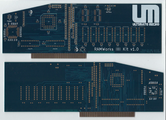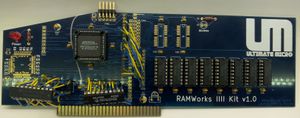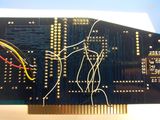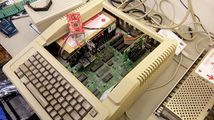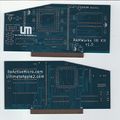RAMWorks IIII Kit
The RAMWorks IIII Kit is a user assemblable project based on the AE RAMWorks III card. The design allows for 4Megs of AUX RAM in the IIe as compared to the 3 Meg limit on the RAMWorks III.
It was conceived, created, and designed by Henry of ReActiveMicro and released for sale to the Apple II Community on June 10th, 2016. The original PCB bore the "UM" Ultimate-Micro logo till it's rerelease in 2017. The project was technically a collaborative effort with UltimateApple2.
Project Status: Complete. In production. Actively sold by ReActiveMicro.
Project License: ReActiveMicro Open Source license.
Support: Post on the Discussion page (link above) or email ReActiveMicro Support.
Sales: Visit the ReActiveMicro Store.
History
In December 2015 Henry had an idea to make a “kit” form of the RAMWorks III card but with 4Megs of RAM. This project would accomplish several goals. One is to move the RAMWorks design from 256k x 1bit DRAMs to more economical and more dense options such as those used on the 8Meg RAM Card project (4Meg x 4bit). The project would also be the starting “proof of concept” design for the RAMWorks Ultimate project which would be 16Megs and have built in RGB - as a "fully loaded" RAMWorks III from AE was offered. Since the project is planned to be in kit form, this allow it to be sold for use at the SolderFEST session at KFEST 2016and thus generate funds and PR.
The RAMWorks IIII Kit v1.0 project was released for sale to the Apple II Community on June 10th, 2016. At the date of release ReActiveMicro was still in the process of setting up and testing their new Store and Wiki. So the project became a "collaborative" release with UltimateApple2 in order to have Kits available and for delivery at KFEST 2016.
Up till August 2016 the Ultimate-Micro.com Store was the only vendor who distributed the project. Then as part of ReActiveMicro.com's full return from hiatus with their new Store and Website release they took over sales and distribution to better serve and support the Apple II Community. At this time the PCB was also revised with the ReActiveMicro logo.
On May 20th, 2017 ReActiveMicro re-released the RAMWorks IIII Kit as v1.1 at a new lower price and with now matching SOJ to DIP Adapters. The v1.0 version had green Adapters and the PCB was blue. Now all parts are blue. The rerelease date could have been sooner however other projects took priority. Also, at this time no other vendor is offering a 'full card' solution. Kits will also be available once again for SolderFEST at KFEST 2017.
The Name: IIII vs. IV
Why “IIII” and not “IV”, or To V or Not To V: As in keeping with Roman tradition since Roman Numerals are used, the “IIII” is called “A Watchmaker’s Four”. Originally, it was common to use IIII to represent four, because IV represented the Roman god Jupiter, whose Latin name, IVPPITER, begins with IV. The subtractive notation which uses IV instead of IIII has become the standard notation only in modern times. Also we used IIII because it's easily recognizable as four. IV involves a little math. Yes, it's just one simple subtraction operation, but keep in mind that we have found there are people who place an order don’t even bother to read the item’s listing, and perhaps the RAMWorks IV would be confused as medical equipment and we would be responsible for a few Community member’s death.
Project Revisions
Alpha Version: Henry started development on January 29th, 2016 by creating an Alpha PCB layout based on the original RAMWorks III design by AE and combining the "Proof of Concept" and "Alpha" phases. We knew from experience with the IIgs 8 Meg RAM Card project and the datasheet of the proposed DRAM that it will easily emulate the older 256k DRAMs that were used on the original RAMWorks III, so we skipped the Proof of Concept phase. The Line Driver ICs were kept in the design as they are needed to drive the Apple II buses. However the rest of the RAMWorks III circuits would be moved in to a CPLD. Any changes or mods needed to the PCB could easily be made using flywires. Henry fully wired and assembled the Alpha boards as shown below.
- RAMWorks IIII Kit Alpha PCB
-
Alpha PCB
-
The RAMWorks IIII Alpha Proto - Testing 256k RAM
-
The RAMWorks IIII Alpha Proto - Rear
-
The RAMWorks IIII Alpha Proto, Installed in IIe, Connected to Logic Analyzer, Testing 4MB RAM
Beta Version: While working on the Alpha design any issues found and corrected were added to this design. Layout was completed on May 22nd and PCBs were ordered. Any changes needed could be done within the CPLD, and all that was left to do is fully test the PCB. Assuming this PCB version worked it would be released for sale.
v1.0: The Beta version worked perfectly and the project was completed and released for sale to the Apple II Community on June 10th, 2016. These boards bare the "UM" Ultimate-Micro logo and the project was technically a collaborative effort with UltimateApple2 although all design work and testing was performed solely by Henry.
- RAMWorks IIII Kit v1.0 PCB
-
v1.0 PCB
First, v1.1 marks the project transitioning from an Ultimate-Micro "collaborative" project to a fully solo ReActiveMicro project.
Second, the RM logo was added to the front and rear of the PCB.
the project is now Open Source under the ReActiveMicro Open Source license.
Project Design Files
The following design files are released under the ReActiveMicro Open Source license.
The concept and desire behind wanting to be Open Source: ReActiveMicro endeavors to share knowledge and work with the Community without the worry of others taking this information and using it against us to compete. We do not wish to compete with others, and in return we wish the same respect be given. We hope by being Open Source we help spur on others to learn, improve our projects, and even create their own which ultimately benefits the Community. If these changes are impressive or unique in some way which adds value to a ReActiveMicro project then it is up to ReActiveMicro's discretion to offer rewards or incentives for work performed. We don't look to corner or dominate any markets, but hopefully create alliances and partnerships along the way to the benefit of the Community, and influence it's growth and health long after we are gone. To have someone value our work enough to credit or reuse it is what we consider the ultimate sign of respect and homage, and in a way a "geek" form of immortality. And to these people I personally thank you. - Henry
